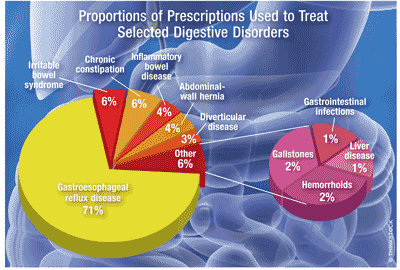US Pharm. 2013;38(12):60.
In 2010, 70 million people with digestive disorders made 104.7 million visits to healthcare providers in ambulatory care settings. During these visits, 20 million patients underwent surgical diagnostic and therapeutic procedures. In 2010, 285 million drugs were dispensed or prescribed for stomach and abdominal pain during 74% of all outpatient visits to nonfederal short-stay and general hospitals. Of the $141.8 billion expended on digestive disorders, 69% were direct costs.

Prescriptions: A total of 97.3 million prescriptions were dispensed for gastrointestinal (GI) disorders. Gastroesophageal reflux disease (GERD) was treated with five proton pump inhibitors (PPIs) for 77.3% of the total cost and 66.4% of the total number of prescriptions. Other costly drugs were mesalamine (inflammatory bowel disease [IBD]), ranitidine, tegaserod (irritable bowel syndrome [IBS], and constipation), and ribavirin and peginterferon alfa-2a (hepatitis C).
Prevalence: GI infections were the most prevalent form of digestive disease (135 million patients, or 33%). Of the remaining 67%, 87 million patients suffered from hemorrhoids, 63 million from chronic constipation, 62 million from GERD, 20 million from gallstones, 15.3 million from IBS, and 15.5 million from peptic ulcer disease (PUD). The least prevalent form of digestive disease was IBD (0.98 million).
Ambulatory Care Visits: For every 100 patients, 35 ambulatory care visits were made for digestive disorders. More than half of ambulatory care visits for GI infections occurred in patients younger than 15 years. The rate of visits was 45.7% higher among white than among black patients, and 18.1% higher among females than among males. The rate of ambulatory care visits increased from 26.4 per 100 patients in 1992 to 35.3 per 100 patients in 2005. GERD patients made the most visits (18.3 million) to ambulatory care settings, followed by 6.3 million visits by patients with chronic constipation.
Hospitalizations: There were 4.6 million discharges of patients with digestive disease as the first-listed diagnosis and 13.5 million discharges of those with digestive disease as the all-listed diagnosis. Of the digestive disorders, GERD was the most frequent reason for hospitalization (3.1 million; 34.4%), followed by diverticular (9%) and liver disease (8.4%). The proportion of hospitalizations was fairly equal (5%) for PUD, pancreatitis, and GI infections, and hospitalization due to IBD and IBS was least frequent (2.4%). The number of discharges from hospital inpatient care for chronic liver disease and cirrhosis was 101,000, but the rate of deaths attributed to these disorders was 10.3 per 100,000 patients.
Mortality: Of all digestive disorders, liver disease was the most common cause of death (59.5%), followed by viral hepatitis C (7.6%) and GI infections (7.3%).
To comment on this article, contact rdavidson@uspharmacist.com.





